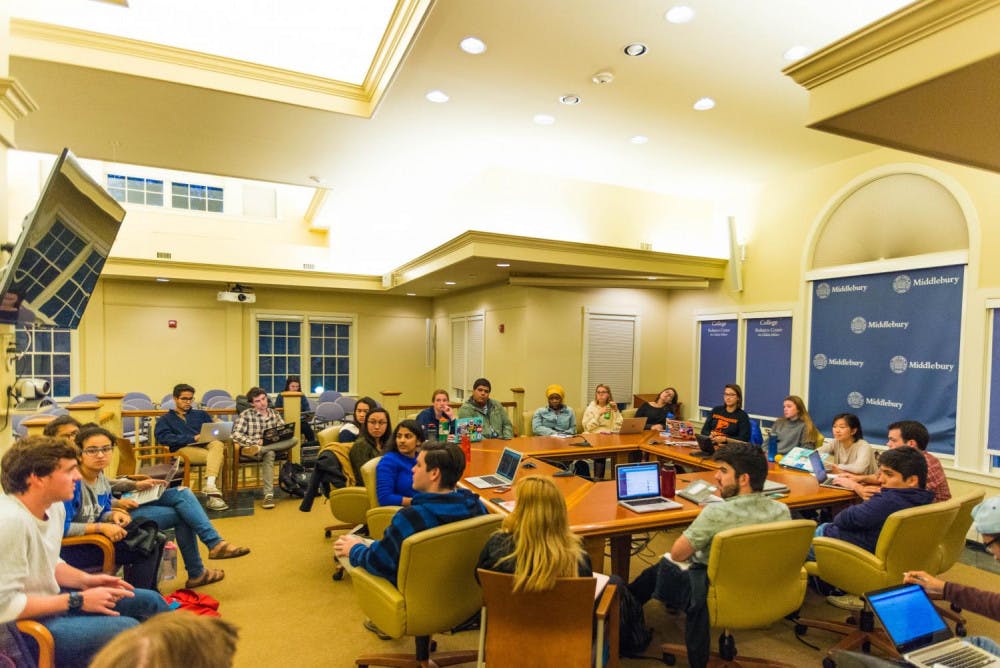The Student Government Association (SGA) has recently formulated a common agenda in collaboration with the administration and President of Middlebury Laurie L. Patton. The agenda lists nine specific points that the administration and the SGA will collectively work to address in the coming years.
Patton proposed the creation of a common agenda during the SGA’s fall retreat in September as a way of addressing a multitude of concerns and suggestions expressed by the student body.
“During meetings in September, we’ve talked with SGA about what was on their minds, and what was on ours,” Patton said. “And it seemed right to both of us that we could come up with a common list of ideas that we work on together.”
“During our fall retreat, Laurie Patton came and talked to us about a series of propositions we as the SGA had collectively decided on,” said SGA Deputy Chief of Staff Annie Cowan ’18. “She brought her own ideas coming in, and we essentially meshed them together with ours.”
The nine points currently included within the common agenda are as follows: expanding general transparency and communication, developing a “How Midd Works” program to explain the basic functions of various college bodies, creating a new set of Middlebury traditions, improving SGA and administrative accessibility, adjusting dining services, communicating changes made over the summer, reviving the “We the Midd Kids” consulting platform, developing public spaces that accommodate student art and altering McCullough Student Center to become more student-centric.
Both the SGA and Patton hope that the establishment of a common agenda will strengthen collaboration and communication between the student body and the administration moving forward.
“In the past, a lot of what the SGA did and what President Patton’s Senior Leadership Group (SLG) did felt distant, similar to a call-and-response type of relationship,” said SGA President Jin Sohn ’18. “For this year, we want to focus on building a closer relationship with the SLG by creating a set of benchmark goals together.”
“I know that I and my colleagues in SLG are interested in getting work done with students that we all care about,” Patton said. “Why not make a regular custom of creating a work plan at the beginning of the year, so that we can refer back to that and see how we’re making progress? Then we can actually focus on what we have in common.”
Regarding the implementation process, the SGA is still debating whether to convert the agenda into a piece of legislation that the Senate may vote on.
“There’s no formal process of doing this, since it has never been done before,” Sohn said. “We don’t have to make the agenda into legislation if it isn’t necessary, but if it would make the plan more available to the student body, then it is probably something we will do.”
The SGA has, however, begun assigning senators to focus on specific points within the common agenda based on their interests and committee specializations.
“We asked different senators to let us know which particular points of the common agenda they were interested in working on alongside their existing initiatives,” SGA Chief of Staff Ishrak Alam ’18 said. “That sort of delegation will be important to make sure that no point or discipline goes unnoticed.”
Both Patton and SGA members acknowledge the long-term nature of certain agenda initiatives, particularly those calling for the alteration of buildings on campus.
“There are long term goals and short term goals,” Patton said. “The ones involving changing buildings usually involve a lot more than just students. They also involve consultations with faculty, staff, and trustees as well. They are also the most costly. So they will take multiple years to effect change. But that doesn’t mean we shouldn’t start now by hearing from students and developing a plan.”
While a portion of the agenda’s initiatives will not be implemented by the end of this academic year, the SGA hopes that establishing overarching goals alongside the administration will set a precedent for future years.
“There are nine big items on the common agenda, and we recognize that we won’t be able to get all of them done this year,” Alam said. “The idea of a common agenda with the administration and the SGA working together is one that we hope will last, and one that we will work together with the incoming leadership for next year to instill.”
“I think the point of the common agenda is to create a year-by-year description of the goals that exist between the SGA and the administration,” Cowan said. “Hopefully, the next group of SGA members will work again with the administration to form an agenda for whatever problems that might arise in the future.”
While the common agenda will remain a priority for the SGA, student leaders will still work to address alternative concerns that are not explicitly mentioned within this collaborative framework.
“The things that are on the common agenda are not the only things the SGA will be working on,” Sohn said. “There are some things that the SGA might disagree with the SLG about, and those are things that probably won’t make the common agenda.”
The SGA hopes to release a finalized version of the common agenda at some point either this week or next week to allow for student feedback.




